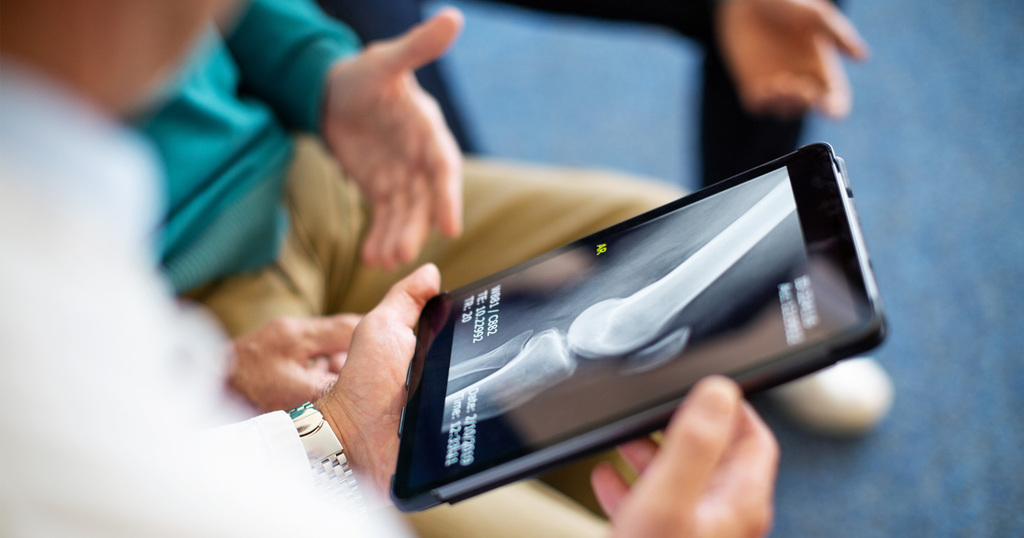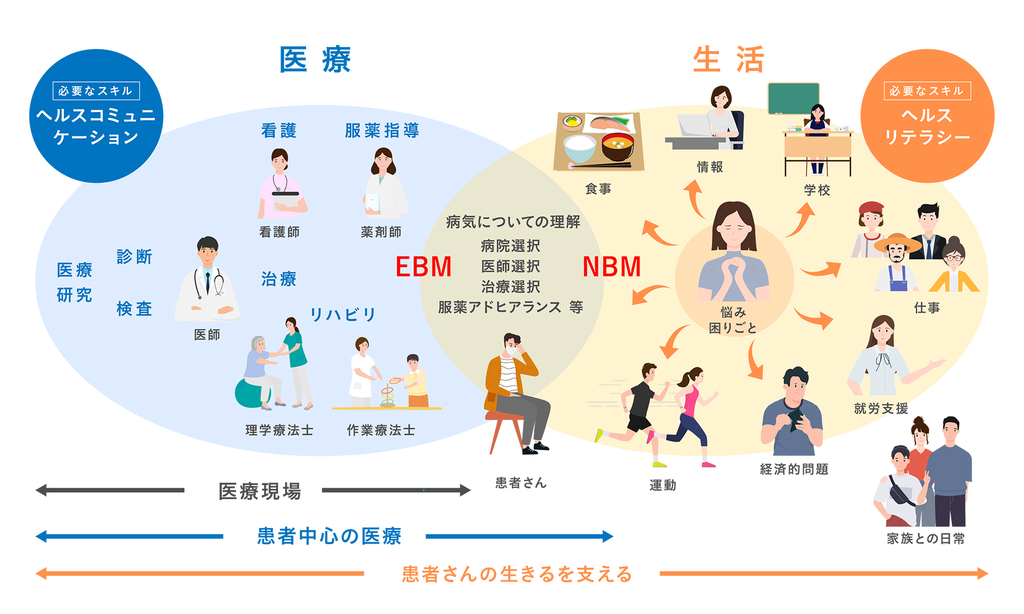DX in the medical and healthcare business requires a humanistic perspective.
Numerous companies are showing interest in the medical and healthcare business market, entering it with a sense of necessity and launching new ventures and activities. The digitalization of healthcare, particularly accelerated by the impact of the COVID-19 pandemic, has evolved rapidly, giving rise to the new market of digital health. This article explains the key points for new entrants to achieve success in creating businesses centered around DX.
Current State of Healthcare Business and Entry Challenges
First, let's clarify what kinds of businesses companies are developing in the medical and healthcare fields and what challenges they face. While there are various ways to classify these, here we will explain medical as "services utilized within medical institutions" and healthcare as "actions and health management for maintaining and promoting health, including self-medication (self-treatment)."
Businesses in the Healthcare Sector Bound by Various Regulations
Services in the medical field can be broadly categorized into the following three types:
- Medicines, medical devices, regenerative medicine products, etc., provided by healthcare professionals for diagnosis and treatment
- Services and systems utilized in clinical settings
- Services and systems used by patients
Category 1 represents the core of healthcare. In business, being bound by various regulations can sometimes pose challenges. For example, regulations under the Pharmaceuticals and Medical Devices Act (PMDA). Additionally, if a company is a member of the Pharmaceutical Manufacturers Association of Japan (PMAJ), an industry group for research and development-oriented pharmaceutical companies like new drug manufacturers, it must also comply with voluntary standards such as the "PMAJ Code of Practice," the Charter of Conduct, and the "Guidelines for Transparency in Relationships between Corporate Activities and Medical Institutions." Furthermore, the Ministry of Health, Labour and Welfare has published the "Guidelines on Sales Information Activities for Prescription Drugs." These guidelines impose responsibilities not only on pharmaceutical manufacturers and distributors but also on companies contracted or partnered for sales information activities and pharmaceutical wholesalers. Regulation covers not only information provided to healthcare professionals but also disease awareness advertising targeting the general public. Thus, companies operate under strict rules to protect public health.
2 refers to electronic medical records, online consultation platforms, and claims processing systems. While used in clinical settings, these are not medical devices, making this a field with many new entrants, including ICT companies. However, since the fees medical institutions receive are set by the government, introducing new services does not necessarily increase income compared to traditional methods. Therefore, the decision to adopt new services or systems involves weighing the labor costs associated with analog methods against the initial and ongoing costs of ICT implementation. Another characteristic of the healthcare industry is that many professionals, including private practitioners running their own clinics and pharmacists, are not bound by mandatory retirement age systems. Consequently, whether a service can be effectively used by older healthcare providers is also a crucial consideration.
Category 3 includes appointment and payment systems for medical institutions, as well as health management systems. Apps or services provided by medical institutions that allow patients themselves to record health information also fall under this classification. However, if an app has therapeutic effects, it is treated the same as medical devices in Category 1. Like Category 2, this is an area with many new entrants. However, even after clearing the provider-side regulations mentioned in Category 1, widespread adoption is difficult unless the design considers the convenience and effectiveness for the users, such as patients and their families.
While categories 1 through 3 each present challenges such as heavy regulation and high entry barriers, they hold the potential for rapid market share expansion if companies can develop products, services, or systems capable of overcoming these hurdles. Consequently, numerous companies are currently advancing business development to seize these opportunities through DX.
Healthcare Business Opportunities Expanding to Other Industries
Meanwhile, business in the healthcare domain can be broadly categorized into the following four areas:
- Products for patients to use in their own treatment
- Products for preventing illness
- Products for maintaining and enhancing health
- Products for beauty
Each category includes "products," "services or systems," and "facilities." As in the medical field, specific laws, regulations, and industry rules govern each, and compliance is mandatory.
Currently, digital transformation (DX) in the healthcare sector is accelerating rapidly, with new entrants continuing to increase. New possibilities are expanding due to the interplay of factors such as the widespread adoption of personal communication infrastructure, advancements in technologies like sensing and data analysis, and rising health consciousness among people. Market entry by electronics manufacturers, telecommunications carriers, system providers, and venture companies is active. GAFA (Google, Amazon, Facebook, Apple) are also part of this, and fierce competition is unfolding.
DX in the Medical and Healthcare Sectors, Driven by Increased Health Awareness and Technological Advancements

As noted previously, the medical and healthcare sectors are highly regulated, presenting significant barriers to entry and intense competition. Despite this, the continued influx of new entrants is largely driven by two key factors.
First, the market is projected to continue expanding. Based on government estimates, the total market size of the medical and healthcare industry, which was approximately 55 trillion yen in 2018, is expected to exceed 100 trillion yen by 2040. The second factor is the rising health consciousness among people. In this era dubbed the "100-year life," more individuals prioritize health to live fulfilling lives, and interest in medical and healthcare services will continue to grow.
While this expanding market attracts new entrants, it also faces the challenge of not fully leveraging the power of digital technology compared to other industries. What kind of DX is unfolding in the medical field? Let me give a few examples.
Traditional healthcare involved evaluating symptoms and conditions through face-to-face consultations, with the details recorded by hand in medical charts by physicians. Prescriptions and treatments were then administered based on these charts, following clinical guidelines and evidence. However, advancing DX is transforming healthcare settings. Integration of ICT medical devices with electronic medical records, digitization of consultations through online medical services, and utilization of hospital-wide collaboration systems have enabled the provision of medical services far more efficiently than before.
Furthermore, digital therapeutics (DTx) are emerging as a promising third treatment modality, following drug therapy and non-pharmacological treatments. DTx refers to the use of digital technology to perform medical acts such as disease prevention, diagnosis, and treatment. For example, in December 2020, Japan's first smoking cessation treatment app received regulatory approval and insurance coverage, leading to its launch. The Ministry of Health, Labour and Welfare's publication of the "Guidelines on the Applicability of Programs as Medical Devices" has also encouraged companies to advance development toward DTx.
Additionally, development is progressing on various other apps, including online consultation apps, medication support apps for patients and their families, and communication apps between pharmaceutical companies' medical representatives (MRs) and healthcare professionals.
Improving healthcare quality requires a dual approach: evidence and narrative

While DX advances as if to make up for past delays, changes are also visible in communication between patients and healthcare providers and in the nature of healthcare itself. Previously, healthcare was fundamentally based on EBM (Evidence-Based Medicine), which relied on research findings in medicine and healthcare. Recently, however, NBM (Narrative-Based Medicine) has also come to be considered important. NBM, proposed by a British general practitioner, is a form of medicine that seeks to understand "why and how the patient became ill" and "how they currently feel about their illness." It approaches the problems faced by patients not only from a physical perspective but also from mental, psychological, and social viewpoints.
Why has this approach gained prominence? While patients naturally seek medical treatment outcomes, they also strongly desire healthcare that involves human connection and warmth. Maintaining a quality of life that feels true to oneself is just as important as symptom improvement. Of course, evidence-based medicine remains crucial; NBM is not meant to replace EBM. Rather, they are seen as complementary approaches that together provide higher-quality care. They are, in essence, two wheels of the same cart, working together to deliver the best possible care for patients.
In recent years, advances in DX have enabled efficient collection and analysis of evidence from medical big data, driving progress in EBM-based healthcare. However, capturing and processing patients' voices and insights as data remains challenging, presenting a key hurdle for advancing NBM. Therefore, moving forward, it will be essential to advance DX while also incorporating a humanistic perspective focused on how well we can consider patients' lives and feelings. Of course, DX and humanism are not mutually exclusive. For instance, while healthcare settings face chronic staffing shortages, DX-driven operational efficiencies can resolve these issues, freeing up more time for patient communication. This, in turn, should enhance the quality of care.
In healthcare business, we must never forget to always consider things from the patient's perspective. Healthcare professionals at the core of medical care possess a deep awareness and sense of mission that their profession saves and supports lives. Companies involved in healthcare must also develop products and services not only to improve the convenience for healthcare providers but crucially to enhance the quality of care delivered to patients.
The healthcare business is changing at a rapid pace. Compounded by the environmental shifts brought by COVID-19, numerous difficult problems and barriers to overcome exist. For those considering new entry into this field or developing new services, we hope you will find the points shared here useful. Furthermore, Dentsu Medical Communications Inc., as a professional in the medical and healthcare business, collaborates with various Dentsu Group companies possessing expertise in diverse fields to provide services and solutions designed to ensure business success in this sector. We would be delighted to assist you in creating new business opportunities.
The information published at this time is as follows.
Was this article helpful?
Newsletter registration is here
We select and publish important news every day
For inquiries about this article
Author

Keiji Ogata
Dentsu Medical Communications Inc.
After serving as an MS at pharmaceutical wholesaler Suzuken and launching sales and digital operations at Medical Tribune, a media outlet for physicians, he joined Dentsu Inc. Medical Communications in 2018. Leveraging over 30 years of experience in the healthcare industry, he handles a wide range of responsibilities from marketing communications to new business development.
